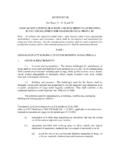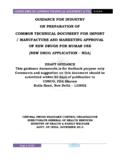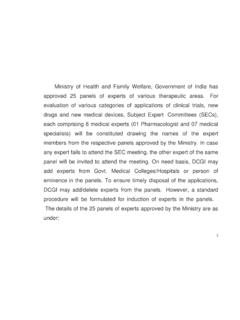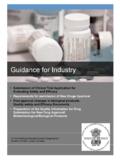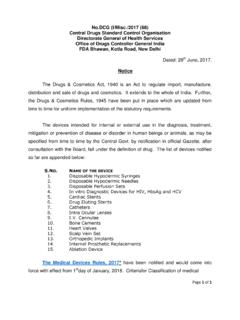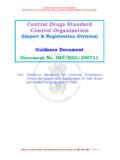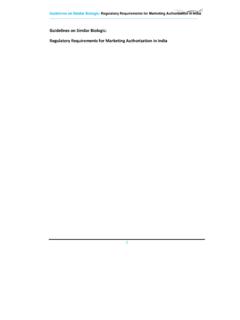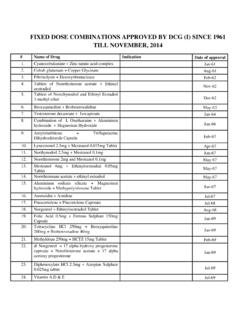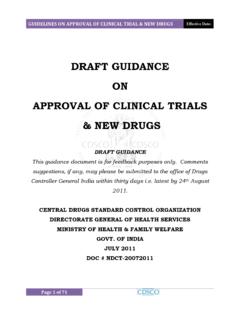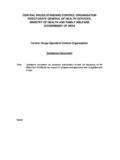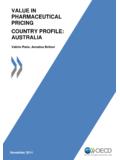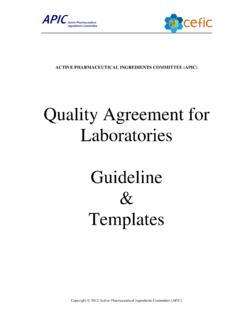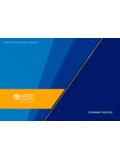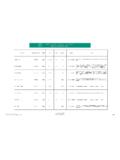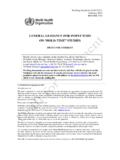Transcription of pharmacovigilance requirements for biological products
1 Guidance for industry onpharmacovigilance requirements for biological productsPage 1 of 71 Guidance for industry on pharmacovigilance requirements for biological Products2 PREFACE this is in consonance with the objective of the drugs & cosmetics act 1940 and rules 1945 there under and other functions of cdsco wherever applicable. these guidelines are intended for the guidance of the marketing authorization holders (mahs) manufacturers and importers of biological products . the procedure set out to facilitate the industry to submit the documents as per the requirements of drugs and cosmetics act and rules. Guidance documents may be amended from time to time as per requirements after obtaining necessary approval from the competent central drugs standard control organization (cdsco), being the apex regulatory authority for approval of drugs in india, is committed to safeguard and enhance the Public health by assuring the safety, efficacy and quality of drugs, cosmetics and medical has extensive pharmacovigilance activities for vaccines as part of post licensure submissions in form of Psurs, Pms studies, aefi case reports and individual case safety reports (icsrs) received by PvPi at iPc.
2 The present document is developed to provide the guidance to all the stakeholders including the marketing authorization holders on the coordinated activities of the various departments within the ministry of health and family Welfare to work together and enhance the pharmacovigilance of guidance document has been prepared in line with the recommendation of the nra assessment 2012 to provide guidance for the mah to perform specific safety study throughout the product life cycle and to define the roles and responsibilities of all the stake holders namely cdsco, PvPi at iPc, immunization division, mah, private and public practitioners and outlines the risk minimization action Plan. this could provide guidance to the manufacturers and importers of vaccines in the country to strengthen their adr monitoring and pharmacovigilance department to ensure patient for industry on pharmacovigilance requirements for biological Products4 AbbREviAtiOns1.
3 Introduction objective Background rationale scope2. roles and resPonsiBilities of authorities cdsco iPc aefi secretariat, immunization division of ministry of health and family Welfare pharmacovigilance division (human vaccine) at cdsco3. pharmacovigilance Plan pharmacovigilance methods Post marketing surveillance/ Periodic safety update report Post marketing trials (Phase iv)4. roles and resPonsiBilities of marketinG authorization holder5. develoPment and use of risk minimization action Plans6. definitions7. references8. aPPendicesContents5 AbbREviAtiOns:ade adverse drug eventadr adverse drug reactionaefi adverse event following immunizationcdl central drugs laboratorycdsco central drugs standard control organisationcrf case report formdcG(i) drugs controller General (india)
4 Dio district immunization officerdov date of vaccinationePi expanded Programme on immunizationfcif final case investigation formGcP Good clinical PracticesGmP Good manufacturing PracticesGlP Good laboratory Practicesicsr individual case safety reportsiPc indian Pharmacopoeia commissionitsu immunization technical supportive unitmah marketing authorization holderncc national coordinating centrenra national regulatory authorityPBrer Periodic Benefit risk evaluation reportPcif Preliminary case investigation formPsur Periodic safety update reportPhfi Public health foundation of indiaPvPi pharmacovigilance Programme of indiasePio state ePi officeruiP universal immunization ProgrammeGuidance for industry on pharmacovigilance requirements for biological Products61. intRODuCtiOn:over the last three decades, india has become a vibrant hub of vaccine manufacturing units with state-of-the-art facilities at par with the international manufacturing standards.
5 Today every third child in the world is administered with the vaccine of indian origin. india can now boast of producing safe, effective and affordable vaccine products which safe guard millions of children in domestic and international market. this responsibility warrants additional effort of constant vigilance of vaccine products moving in the pre-market mandatory clinical trial has little scope to assess the inherent risks associated with the nature of antigens /excipients formulation or that cropping up due to specific manufacturing process and raw materials usedrisk assessment during product development should be conducted in a thorough and rigorous manner; however, it is impossible to identify all safety concerns during clinical trials. once a product is marketed, there is generally a large increase in the number of patients exposed, including those with co-morbid conditions and those being treated with concomitant medical products .
6 Therefore, post marketing surveillance which may be passive or stimulating have major role to assess the actual safety aspects of the vaccine product . safety data collection and risk assessment based on observational data are critical for evaluating and characterizing a product s risk profile and for making informed decisions on risk guidance document focuses on pharmacovigilance activities on a vaccine product circulating in the market throughout its life cycle post licensure period. this guidance uses the term pharmacovigilance to mean all scientific and data gathering activities relating to the detection, assessment, and understanding of adverse events. pharmacovigilance principally involves the identification and evaluation of safety signals. in this guidance document, safety signal refers to a concern about an excess of adverse events compared to what would be expected to be associated with a product s use.
7 Signals can arise from post marketing data and other sources, such as preclinical data and events associated with other products in the same pharmacological class. it is possible that even a single well documented case report can be viewed as a signal, particularly if the report describes a positive re-challenge and de-challenge or if the event is extremely rare in the absence of drug use. signals generally indicate the need for further investigation, which may or may not lead to the conclusion that the product caused the event. after a signal is identified, it should be further assessed to determine whether it represents a potential safety risk and whether other action should be ObjECtivE:this document intends to be an aid to the marketing authorization holders (mah) and other allied stake holders who play active role in launching, distribution and bringing the vaccine products to its end main focus of this guideline is to identify the risks, formulate the risk profile of a vaccine and its administration programme, design of appropriate pharmacovigilance plan to mitigate such risks and to explore the missing critical information which did not emerge during pre-market phase-i/ii/iii trials and therefore safety profile had not been bACkgROunDthe decision to approve a drug is based on its having a satisfactory balance of benefits and risks within the conditions specified in the product labeling.
8 This decision is based on the information available at the time of approval. the knowledge related to the safety profile of the product can change over time through expanded use in terms of subject characteristics and the number of patients exposed. in particular, during the early post marketing period the product might be used in settings different from clinical trials and a much larger population might be exposed in a relatively short a vaccine is marketed, new information might emerge, which may have an impact on the benefits/risks ratio of the product . evaluation of this information should be a continuing process in consultation with regulatory authorities. detailed evaluation of the information generated through pharmacovigilance activities is important for all products to ensure their safe use. the benefit-risk balance can be improved by reducing risks to patients through effective pharmacovigilance that can enable information feedback to the users of medicines in a timely RAtiOnAlEthis document rationally place guidance that all marketing authorization holder (mah) of human vaccines(importers and manufacturers)should establish an appropriate pharmacovigilance system with adequate number of qualified, trained, experienced manpower to collect, collate all aefi (minor, severe and serious).
9 This pharmacovigilance system within the company should conduct decisive causality analysis of the collated aefi cases, after due investigation and prepare case closure report. in a comprehensive Psur, all such information shall have to be placed as per the norms stipulated in schedule-y of drugs & cosmetics act 1940 and rules 1945 and submitted to the licencing authority dcG(i) in cdsco (hq) in a timely manner. cdsco shall convene the meeting of Psur committee within a reasonable time period and give opportunities to the concerned marketing authorization holder (mah) to present their case and Psur in general. Based on the recommendation of the Psur committee the vaccine licensing authority dcG(i) will take appropriate regulatory action in accordance with drugs & cosmetics act 1940 and rules 1945, so as to monitor the safety and effectiveness of human vaccine in the market.
10 Mahs must have a system in place that enhances the overall quality of the receipt, processing and reporting of ade while ensuring that accurate and complete pharmacovigilance information is provided to sCOPE this document has been framed in compliance with the provisions made under schedule-y of drugs & cosmetics act 1940 and rules 1945 and Good clinical Practices (GcP) Guidelines of india to provide Guidance to marketing authorization holders (importers and manufacturers of human vaccine) india to establish their pharmacovigilance system to collect all aefi Guidance for industry on pharmacovigilance requirements for biological Products8cases pertaining to their vaccine products across the domestic and export market, after due investigation & causality analysis at their end and collate all such cases in Psur for periodic reporting to the licensing authority dcG(i)
